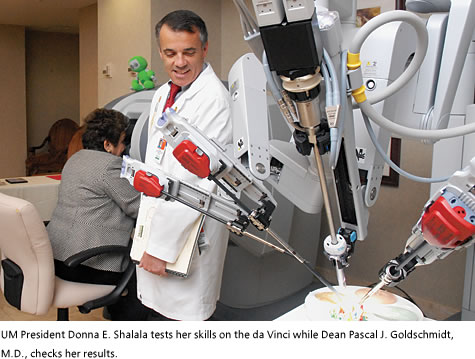Implementing Cutting-Edge Technology
DaVinci Robot Demonstration
Draws Crowd at UM Hospital
Throughout the day on February 29, dozens of people gathered in the lobby of University of Miami Hospital. There was no emergency. Instead, the hospital was showing off its latest device to benefit patients, the da Vinci S HD Surgical System. The state-of-the-art robotic system, made by Intuitive Surgical, is only the second such device available to patients in all of Miami-Dade County.

This next generation of the da Vinci offers several key features that benefit both patient and physician. Instead of the traditional three-arm device, the da Vinci S offers an optional fourth arm that gives the surgeon another set of hands during any procedure. Unlike the two older robots currently employed by UM Hospital and Jackson Memorial Hospital, the camera on the new model provides the surgeon with a three-dimensional view in high definition.
“The resolution of high-def is significantly better,” said Alex Jimenez, clinical sales representative with Intuitive Surgical. “For each specialty, a critical portion of the procedure is enhanced.”
To operate the robot, the surgeon sits at a console and maneuvers two pincher-like devices while peering through a viewfinder that provides the image from the robotic camera. Two robotic arms serve as the doctor’s hands inside the patient, while the image of the surgery being performed is displayed on a separate screen. A special wrist device offers more rotation than is possible with the human hand.
Miller School Dean Pascal J. Goldschmidt, M.D., joined UM President Donna E. Shalala in trying out the equipment. Goldschmidt brought the very first da Vinci commercial prototype to the United States when he was the director of Ohio State University’s Heart and Lung Institute and head of cardiology.
“We are creating a center for minimally invasive and robotic surgery at University of Miami Hospital, and as someone who first recognized this technology as groundbreaking, you can be sure our expertise will be superior with many surgical options for our patients,” said Goldschmidt.
The da Vinci can be used for a wide variety of procedures, including prostatectomy, hysterectomy, ovarian and uterine removal, mitral valve repair, and gastric bypass.
“The robot gives us more precision because of better imaging and 3-D, which allows for a better outcome for the patient,” said Raymond Leveillee, M.D., professor of clinical urology and chief of the Division of Endourology, Laparoscopy and Minimally Invasive Surgery.
Leveillee explained that using robotics results in less scarring and blood loss from a surgery, which also provides an advantage for gynecologic oncology procedures. Laurel King, M.D., a community physician practicing at UM Hospital, uses the da Vinci to treat precancerous conditions of the cervix and uterus.
The da Vinci also incorporates a telestrator feature, which enhances its use as a teaching tool. A physician or student can point out precise sections on the screen to explain a procedure or the next step they will perform. The device’s built-in microphone allows the physician to communicate remotely with the rest of the surgical team or with other people observing the procedure.
Leveillee said, “There’s no question that technology improves human lives.”